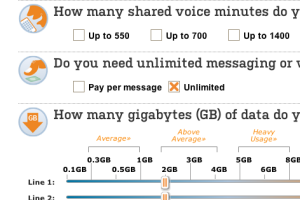Wireless Plan Comparison Calculator Shows Just How Screwed Up Phone Prices Are
 Do you think you’re paying the best possible price for your wireless service? Given that there are around 700 different permutations of plans available just from the four national wireless carriers, it can be complicated to figure out whether you’re getting the most for your monthly subscription.
Do you think you’re paying the best possible price for your wireless service? Given that there are around 700 different permutations of plans available just from the four national wireless carriers, it can be complicated to figure out whether you’re getting the most for your monthly subscription.
Most of the plans start out with the basic charge for service, followed by possible upcharges for additional or unlimited talking time. Then there’s messaging; you can pay per text or just pay a monthly fee for an infinite number of messages.
And of course there’s the cost for data, that nebulous number that many consumers overestimate. The average wireless customer uses around 733 megabytes of data each month, but many of us have plans giving us access to three times that amount each month. According to the Wall Street Journal, about one out of every four AT&T shared-data plans pays for at least 10GB per month in wireless data, just because those customers assume that they will use that amount.
To give consumers a starting point for comparing plans, the Wall Street Journal has created an interactive Wireless Savings Calculator that asks the users a handful of questions and then shows them the rates at each of the four major carriers.
For example, here are the monthly totals for a customer with a single phone with unlimited voice and messaging, and up to 1GB/month in data:

And here is a comparison of individual plans with only 450 minutes of voice time but 3GB/month of data:

Finally, this comparison shows shared plans including 4 wireless devices, each with unlimited voice service and up to 8GB/month for the entire group (2GB/device):

Also of interest is the “2-year price” listed under each figure. That includes the cost of an iPhone 5 (or multiple iPhone 5s in the case of the last example) to show how much a plan would cost if you’re also buying your phone through the carrier.
See the first two examples above. In the top comparison, the $60/month T-Mobile plan is actually $210 more expensive over that 2-year period than the $70/month Sprint plan. Likewise, the $70 T-Mobile plan in the second comparison costs $210 more than Sprint’s comparable plan, and only $30 less than the 2-year cost of the $90/month AT&T plan.
This is because T-Mobile now allows customers to spread the cost of their phone purchases out over the course of two years, but they pay the full sticker price for the phone. Meanwhile, the other three carriers subsidize the cost of the device. If you’re bringing your own phone to the carrier, this doesn’t matter. Similarly, less expensive wireless devices will have less of an impact on this difference between the plans.
For all the helpful pricing information shown in these comparisons, it’s information that isn’t shown on these charts that is often the deciding factor in selecting a provider.
Many wireless customers pick their provider based on the coverage in their area, and while Sprint and T-Mobile are national carriers, they simply don’t have the coverage of the bigger networks. Similarly, customers who require higher-speed wireless data may choose the provider based on the availability of an LTE network in their area. On the flip side of this topic, there are areas of the country where consumers are only served by one or two companies, thus effectively making the choice for them.
Want more consumer news? Visit our parent organization, Consumer Reports, for the latest on scams, recalls, and other consumer issues.

